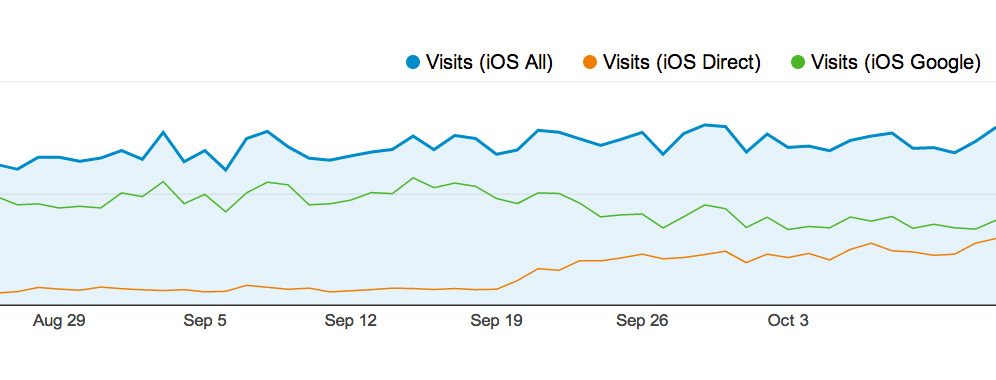Privacy on iOS 6 is a Wake Up Call for 3rd Party Web Analytics Tools
There is much discussion of the way that the goals of advertising and privacy are at odds. But advertising is not the only casualty when browser makers clamp down their privacy settings. Another big category that this will affect is 3rd party analytics tools. Google Analytics (GA), for example, is an extremely powerful (and free) way for website owners to capture aggregate information about visitors in order to figure out what is working and what isn’t.
This is what I was doing this morning — browsing through our sources of traffic in GA — when something jumped out at me. The direct visitors to our site had started climbing rapidly in mid September, faster than any other category. This is strange, because you would expect that “direct” visitors, who have typed your address into the browser address bar, to grow more slowly than “referral” visitors, who came by clicking a link to your site, or than “search” visitors, who found your site using a search engine.
Digging a little deeper, I found that the increase was strictly among new visitors. This might be explained by press coverage in a printed publication or a TV mention, situations where someone heard about us but didn’t have a link to click. But I didn’t know about any recent coverage, and this sort of influx of visitors is normally a spike, not sustained growth.
What had changed after September 18 to catalyse this growth? Mid September… My conscious brain was working through any changes we had made on the site during the last month when my subconscious brain tapped it on the shoulder and said: “iPhone 5?”.
Of course. The first people who ordered the new model started receiving them on September 20. And I could quickly confirm that all the additional direct visits from new users were people using the version of Safari in iOS 6.
Still, what exactly was going on? I know there are some privacy settings changes in iOS 6, so my first thought was that Google Analytics was no longer able to distinguish between new and returning visitors. Indeed, the pageviews per user did seem to be dropping.
This didn’t account for the difference though. First, the decline in pages per visit seemed to start earlier than September 20. And second, returning visits from iOS 6 did not go to zero, so clearly GA was able to detect return visitors in some cases. It was something else.
Now that I knew what I was looking for — something in iOS that was impacting analytics — it was only a short search before I found the answer in an article by Danny Sullivan (Search Engine Land). According to Sullivan, it is indeed privacy related, but the issue is that iOS is not allowing Google Analytics to see the referrer (the bit of info that tells it where you came from) when you search from the search box in the Safari browser. (For the nerds, Safari is sending the searches through Google SSL search.)
The analytics for iOS in particular supports their theory. Right around September 20, iOS traffic sources start to shift from Google to “direct”. The rate is probably reflecting the penetration of iOS 6.
My take-away from all this is that the move towards privacy might have a big impact on 3rd party analytics services. Not only GA, but any other service that is running on someone else’s server and gathering info about your visitors via a tracking pixel or JavaScript that you put in your pages. In other words, all of them.
Now might be the time to invest in self-hosted solutions. Several years ago it was all about self hosted analytics, then Google bought Urchin and the move towards 3rd party hosted analytics began. Privacy could put a stop to all that and take us back to the days of running something like Urchin on our own servers. Although losing the power of GA would be sad, a resurgence of self hosted solutions would be awesome. If you have ever tried to find a good and affordable analytics tool to run on your server, you’ll know what I mean.
Posted: October 14th, 2012 under The Wild Web.



